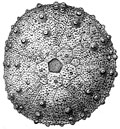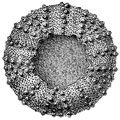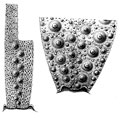The Echinoid Directory
Pseudopedina Cotteau, 1858, p. 221
[?=Polypedina Lambert, 1933, p. 46, type species Polydiadema toutanensis Lambert, 1933; =Soudetaster Vadet, Nicolleau & Riboul, 2011, p. 6, type species Soudetaster martinezae [?=Pedina bakeri Wright 1854] ]
| Diagnostic Features |
|
|---|---|
| Distribution | Jurassic (Bajocian to Oxfordian), western Europe. |
| Name gender | feminine |
| Type | Pseudopedina nodoti Cotteau, 1858, p. 223 by monotypy. Cotteau (1884, p. 662: Paleontologie francaise) later treated this species as a junior synonym of Pedina bakeri Wright, 1854. However, Vadet & Slowik (2001, p. 14) synonymize it with Echinus divionensis Michelin, 1854), which seems more likely given its large secondary interambulacral tubercles. |
| Species Included |
|
| Classification and/or Status |
|
| Remarks |
|



